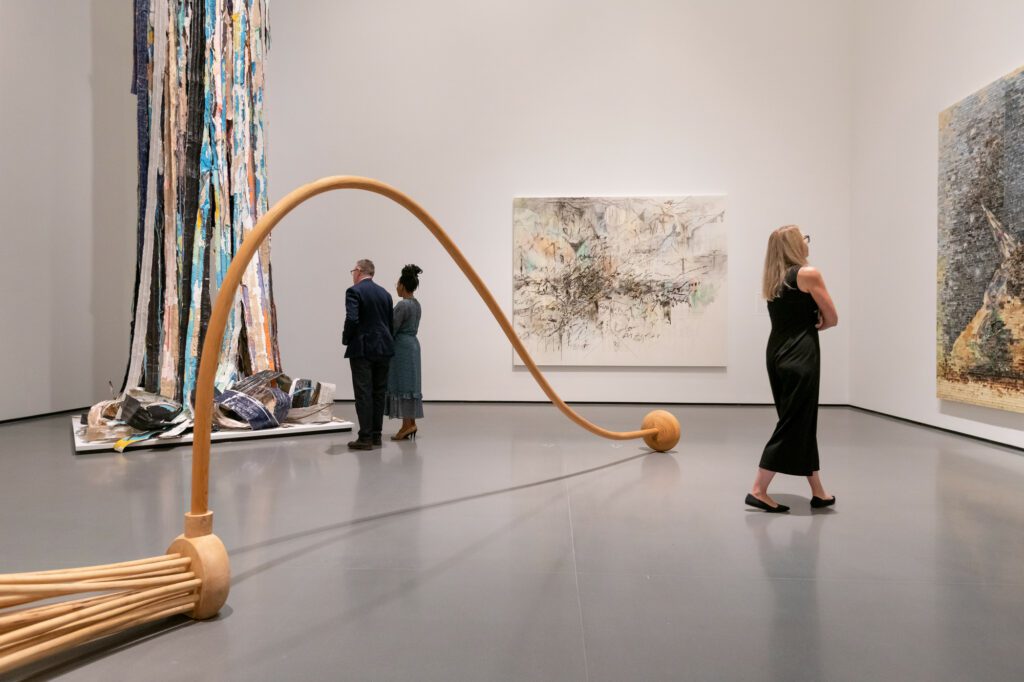The Baltimore Museum of Art, Baltimore, United States
29 Sep 2019 - 19 Jan 2020

Works by Mark Bradford, Julie Mehretu, Martin Puryear, and Jack Whitten on view in Generations: A History of Black Abstract Art. Photo: Maximilian Franz.
The Baltimore Museum of Art (BMA) recently opened Generations: A History of Black Abstract Art, as well as several other group and monographic exhibitions by artists of color and women as part of its ongoing efforts to tell a more multidimensional story of art and artists, and expand perceptions of modern and contemporary art.
“These exhibitions are part of a broader vision to reshape the idea of the museum—who it belongs to and whom it represents. This effort occurs across our special exhibitions, collecting, and public programs. In this way, we can recognize historical shortcomings, and provide our audiences with a richer, more vibrant, and dynamic picture of art—one that speaks to different communities, perspectives, and realities,” said Christopher Bedford, BMA Dorothy Wagner Wallis Director. “We are looking forward to the important conversations these exhibitions may spur.”
Generations: A History of Black Abstract Art (on view through January 19, 2020) offers a new perspective on the contributions black artists have made to the evolution of visual art from the 1940s to the present moment. The exhibition draws on The Joyner/Giuffrida Collection’s unparalleled holdings, along with selections from the BMA’s growing collection of contemporary art and a few key loans, to feature more than 70 paintings, sculptures, and mixed-media works. The story follows pioneering postwar artists Norman Lewis and Alma W. Thomas; the explosive expansion of abstraction achieved by the next generation, including Sam Gilliam, Jack Whitten, Mel Edwards, and Howardena Pindell; and younger artists such as Mark Bradford, Lorna Simpson, Shinique Smith, and Kevin Beasley. The exhibition makes the case for the historical significance of each individual artist and also looks at how they have collectively redefined abstraction.
Melvin Edwards: Crossroads (on view through January 12, 2020) explores the cross-cultural connections in Melvin Edwards’ sculpture through more than 20 works. Since attending a major arts festival of the African diaspora in Lagos in 1977, the artist’s work has increasingly connected to African art, languages, poetry, liberation politics, and philosophy. The exhibition includes sculptures from the artist’s Lynch Fragments series and two large-scale works that tell the story of Edwards’ travels, the people he engaged, and the larger social history of the period.
Every Day: Selections from the Collection (on view through January 5, 2020) is a sweeping reinstallation of the BMA’s contemporary collection galleries that focuses on the creativity of 20th- and 21st-century black artists. Nearly 70 works by such visionary artists as David Hammons, Joyce J. Scott, Mickalene Thomas, Kara Walker, and Nari Ward are seen alongside those by Helen Frankenthaler, Ellsworth Kelly, Andy Warhol, and others, to create a fuller, truer art history. The reinstallation debuts recent acquisitions, including paintings by Amy Sherald and Lynette Yiadom-Boakye, sculpture by John Scott, a drawing by David Driskell, and Isaac Julien’s Baltimore (2003), a monumental, three-screen video that follows a preternatural, cyborg-like young woman and an older man (played respectively by Vanessa Myrie and Melvin Van Peebles) as they navigate the city.
By Their Creative Force: American Women Modernists (on view through July 5, 2020) acknowledges and celebrates the contributions of women artists to the development of American modernism through approximately 20 works from the BMA’s collection by Elizabeth Catlett, Maria Martinez, Georgia O’Keeffe, and Marguerite Zorach, and others. The selection of painting, sculpture, and decorative arts showcases these artists’ innovative engagements with the major art movements of 20th century from Cubism to Abstract Expressionism. Several of these accomplished artists—including Simone Brangier Boas, Grace Hartigan, Elsa Hutzler, Helen Jacobson, Amalie Rothschild, and Grace Turnbull—were based in Baltimore during their careers. This exhibition is the debut of the BMA’s year-long 2020 Vision initiative highlighting women artists and collectors.
Concurrent with these exhibitions are solo presentations of works by Oletha DeVane and Tavares Strachan, as well as collaborations between Joyce J. Scott and the late Elizabeth Talford Scott and Keith Calhoun and Chandra McCormick. The exhibitions and acquisitions are key aspects of the museum’s systemic effort to effect structural change. Other areas of focus include public programs, community partnerships, and the makeup of the staff and board.
.